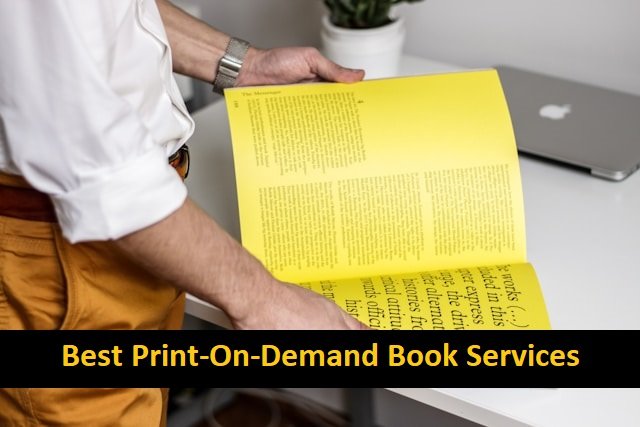
The world of self-publishing has dramatically evolved, offering aspiring authors an unprecedented opportunity to bring their stories to life. Print-On-Demand (POD) services have become a game-changer in this space, enabling authors to publish and distribute books without the need for large print runs or inventory. But with so many POD services available, how do you choose the right one? This article explores the best print-on-demand book services in 2024, highlighting key factors to consider and helping you make an informed decision.
Best Print-On-Demand Book Services
1. Amazon KDP

Amazon’s Kindle Direct Publishing (KDP) is a dominant force in the self-publishing industry. With seamless integration into Amazon’s marketplace, KDP allows authors to reach millions of readers worldwide. The platform offers a straightforward process for both eBooks and paperbacks, but some authors have noted that the quality of print and binding could be improved. Nevertheless, its extensive reach and user-friendly interface make it a top choice for many.
Pros:
- Wide distribution through Amazon
- User-friendly interface
- No upfront costs
Cons:
- Limited customization options
- Quality control issues reported by some users
2. IngramSpark

IngramSpark is renowned for its high-quality print options and extensive global distribution network, including access to bookstores and libraries. It’s an excellent choice for authors looking for professional-grade print products and a wide reach. However, IngramSpark’s platform can be more complex to navigate, and there are upfront costs involved.
Pros:
- High-quality print and binding
- Extensive global distribution
- Access to bookstores and libraries
Cons:
- More complex interface
- Setup fees and additional costs
3. Lulu

Lulu has been a favorite among self-publishers for years, offering a wide range of customization options and the ability to print everything from novels to photo books. Lulu’s marketplace also provides an additional sales channel for your book. The downside is that Lulu’s distribution network is not as extensive as some other services, and the interface can be somewhat outdated.
Pros:
- Extensive customization options
- Supports various book formats
- Additional sales channel through Lulu marketplace
Cons:
- Limited distribution reach
- Outdated user interface
4. Blurb

Blurb specializes in high-quality photo books, art books, and other visually rich projects. It offers a range of tools for both amateur and professional designers, including integration with Adobe InDesign. While Blurb excels in quality, it’s not the best choice for traditional text-heavy books due to higher costs.
Pros:
- Superior quality for photo and art books
- Custom design tools and Adobe integration
- Wide range of formats and sizes
Cons:
- Higher costs, especially for text-heavy books
- Limited to specific types of books
5. BookBaby

BookBaby is an all-in-one self-publishing service that caters to authors looking for both print and digital distribution. It offers professional services like editing, cover design, and book marketing, making it a great option for authors who want a comprehensive package. However, these services come with higher costs, and the print quality, while good, might not always justify the price.
Pros:
- Comprehensive self-publishing services
- Professional editing and design options
- Both print and digital distribution
Cons:
- Higher costs
- Print quality may vary
6. Draft2Digital

Draft2Digital is primarily known for its eBook distribution, but it also offers print services through its Print On Demand option. The platform is user-friendly and provides free formatting tools, making it a great choice for authors who want to streamline the publishing process. However, its print services are still relatively new, so distribution and quality might not be as robust as other platforms.
Pros:
- Free formatting tools
- User-friendly interface
- No upfront costs for POD
Cons:
- Limited print options
- Newer service with less established reputation
7. Barnes & Noble Press

Barnes & Noble Press offers authors the opportunity to publish both eBooks and paperbacks with direct access to the Barnes & Noble online store. This platform is particularly appealing for authors looking to tap into the B&N customer base. While the print quality is generally good, distribution is mostly limited to B&N, which might restrict your book’s reach compared to other services.
Pros:
- Direct access to Barnes & Noble’s store
- Good print quality
- No setup fees
Cons:
- Limited distribution outside of B&N
- Fewer customization options
Comparing the Top POD Services
To help you make the best choice, here’s a comparison of the top services based on key criteria:
Price Comparison: Amazon KDP and Draft2Digital offer the most cost-effective solutions with no upfront fees, while IngramSpark and BookBaby require setup costs that can add up, especially with added services.
Quality of Print and Binding: Blurb and IngramSpark are leaders in print quality, particularly for visually intensive books, whereas KDP, while decent, doesn’t always match up in terms of premium feel.
Ease of Use: KDP and Draft2Digital stand out for their user-friendly interfaces, making them ideal for first-time self-publishers. IngramSpark and Lulu, though powerful, have steeper learning curves.
Distribution and Reach: IngramSpark and KDP offer the widest distribution, with access to both online and physical stores. Barnes & Noble Press, while good for targeting B&N customers, has more limited reach.
Tips for Success with Print-On-Demand Services
To maximize your success with POD services, consider the following tips:
Formatting Your Manuscript: Ensure your manuscript is properly formatted before uploading it to any POD platform. Most services offer templates or formatting guides to help with this.
Designing an Eye-Catching Cover: Your book cover is the first thing potential readers see. Invest time in creating a compelling cover that stands out, or consider hiring a professional designer.
Understanding ISBN and Copyright Requirements: Familiarize yourself with ISBN requirements and ensure your copyright is protected. Some POD services offer free ISBNs, but owning your own gives you more control.
Marketing Your POD Book: Don’t rely solely on the POD service for sales. Develop a marketing strategy that includes social media, book reviews, and possibly even book signings or events to promote your work.
FAQs
1. What is Print-On-Demand (POD)?
Print-On-Demand (POD) is a publishing method that allows books to be printed as they are ordered, eliminating the need for large print runs and inventory storage. This model reduces costs and waste, making it an ideal option for self-published authors.
2. How do Print-On-Demand services work?
Authors upload their manuscript and cover design to a POD platform. When a customer orders the book, the platform prints and ships it directly to the buyer. The author earns royalties from each sale, with the platform handling the logistics.
3. What are the benefits of using POD services?
- No upfront printing costs: Books are printed only when ordered.
- Wide distribution: Many POD services distribute to global markets.
- Customization: Authors can choose from various book formats, sizes, and designs.
- No inventory management: POD eliminates the need to store physical copies.
4. Are there any downsides to using POD?
- Higher per-unit cost: POD books typically cost more per unit than books printed in bulk.
- Quality variations: Not all POD services offer the same print quality.
- Limited control: Authors may have less control over certain aspects of production and distribution.
5. How much does it cost to use a POD service?
Costs vary depending on the platform. Some, like Amazon KDP, have no upfront fees, while others, like IngramSpark and BookBaby, may charge setup fees and additional costs for services like editing and design.
6. Can I publish both eBooks and print books with POD services?
Yes, many POD services, such as Amazon KDP, IngramSpark, and Draft2Digital, offer both eBook and print book options, allowing authors to reach a wider audience across different formats.
7. How do royalties work with POD services?
Royalties are typically calculated as a percentage of the sales price after the printing and distribution costs are deducted. Each platform has its own royalty structure, so it’s important to review the terms before choosing a service.
8. Do I need my own ISBN to use a POD service?
Some POD services provide a free ISBN, while others allow you to use your own. Having your own ISBN gives you more control over the book’s distribution and ensures that you are listed as the publisher.
9. How long does it take to get my book printed and shipped?
Turnaround times vary by service. Most POD platforms can print and ship books within a few days of receiving an order, but this can be longer during peak times or for international shipping.
10. Can I make changes to my book after it’s been published with a POD service?
Yes, most POD platforms allow you to update your manuscript or cover even after publication. However, changes may require a new proof review, and any existing inventory may not reflect the updates.
11. Can I distribute my POD book in bookstores?
Distribution in physical bookstores can be challenging with POD books, but services like IngramSpark offer expanded distribution options that include brick-and-mortar stores. However, acceptance depends on factors like print quality, demand, and retailer policies.
12. Is Print-On-Demand suitable for all types of books?
POD is ideal for most types of books, including novels, non-fiction, and memoirs. However, it might be less suitable for books requiring specialized printing techniques, such as high-quality art books or textbooks with complex formatting.
13. Do POD services help with marketing my book?
Most POD services focus on printing and distribution. However, some, like BookBaby, offer additional marketing services for a fee. Authors are generally responsible for their own marketing efforts.
14. Can I sell my POD book on my own website?
Yes, many POD services offer integration options or provide you with links that you can use to sell your book directly from your own website, keeping more of the profits.
15. What happens if my book doesn’t sell?
Since POD services don’t require large upfront investments, the financial risk is low. If your book doesn’t sell, you won’t be stuck with unsold inventory. However, poor sales may limit your ability to recover costs for services like editing or cover design.
Conclusion
Choosing the best print-on-demand service depends on your specific needs as an author. Whether you prioritize cost, quality, distribution, or ease of use, there’s a POD service that’s right for you. By considering the factors outlined in this article and comparing the top services, you can confidently take the next step in your publishing journey. Remember, the right POD service not only brings your book to life but also helps you reach readers worldwide. Happy publishing!
This article is designed to be informative, helping readers make an informed choice about print-on-demand services.




